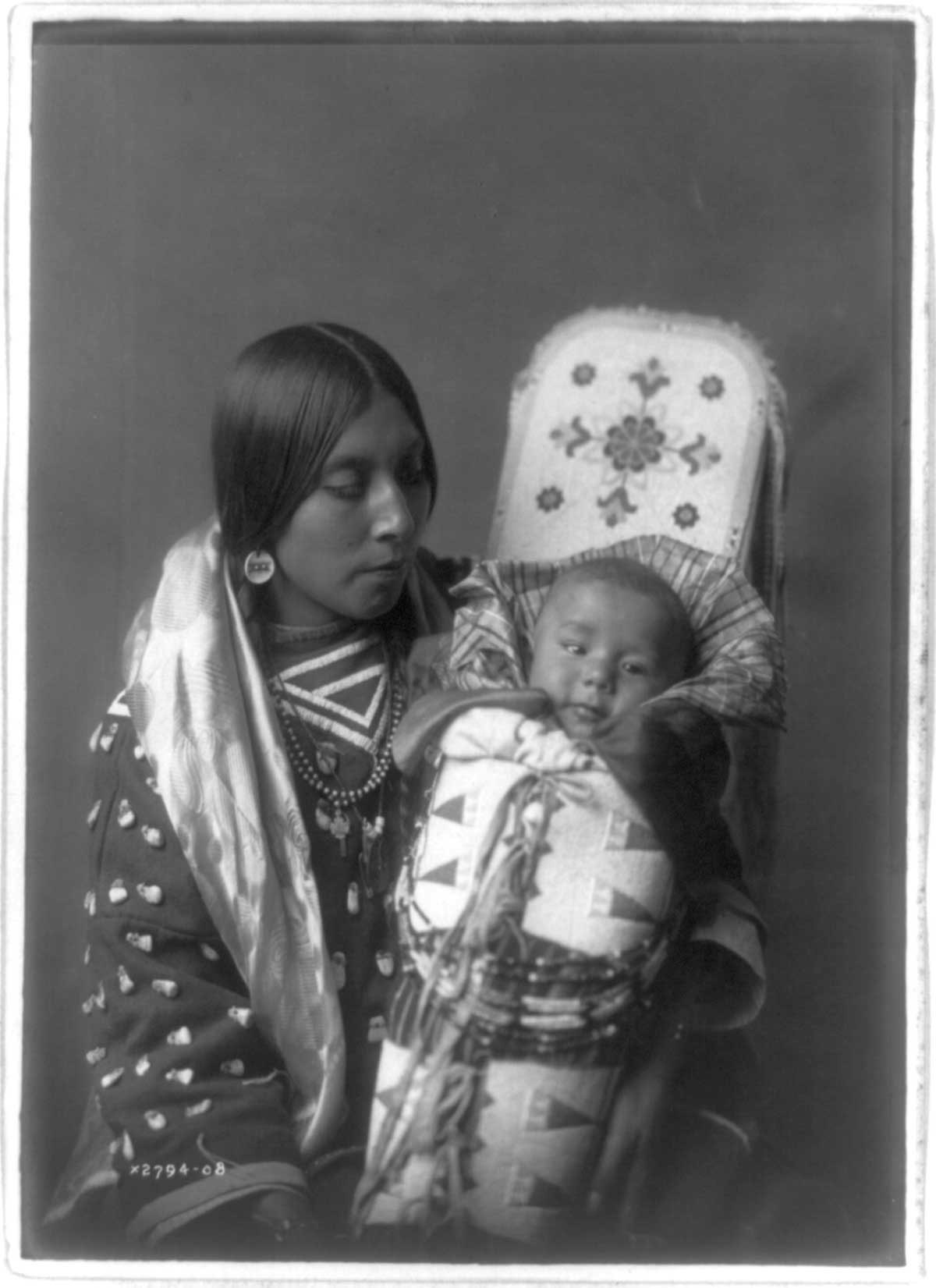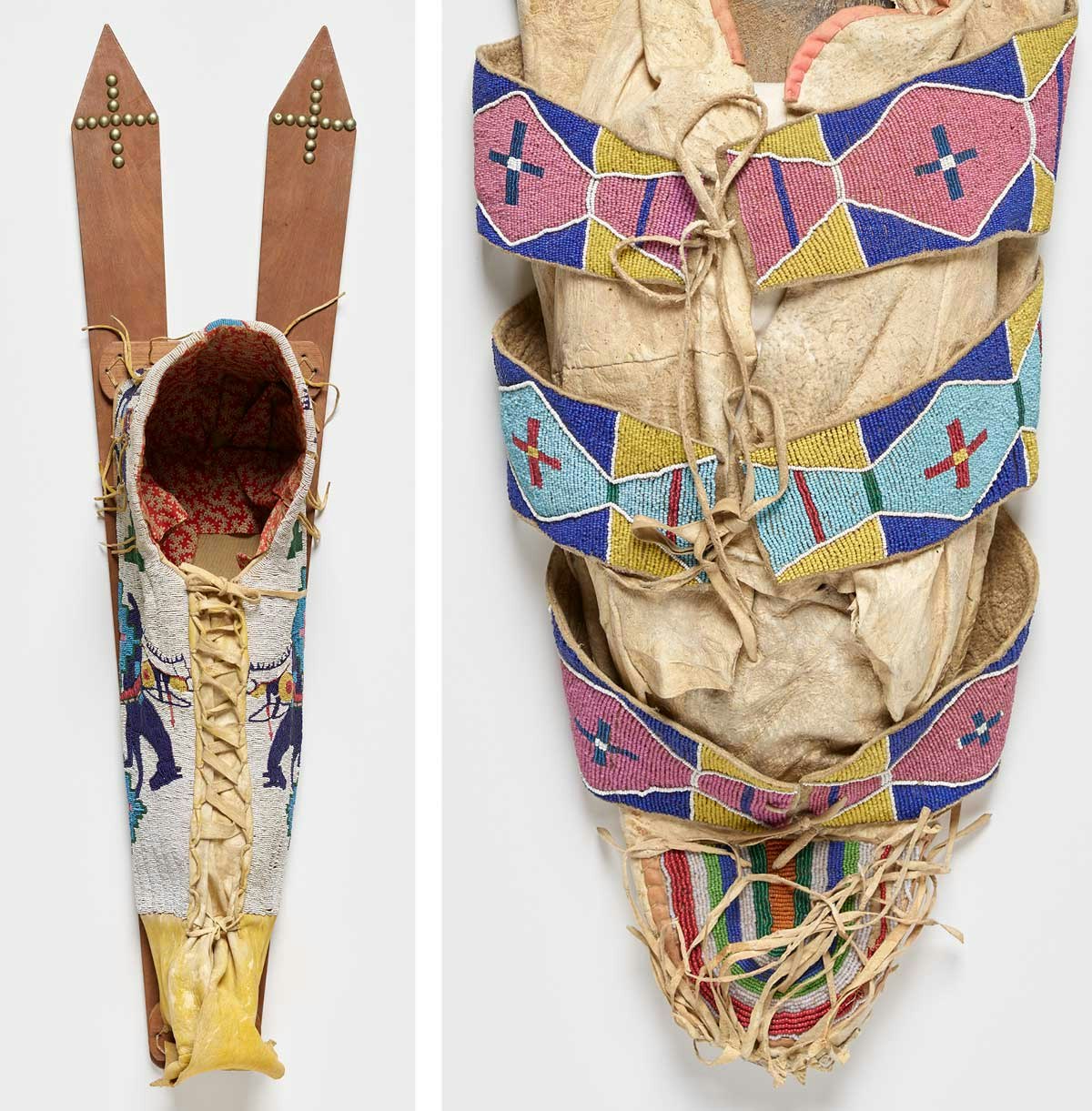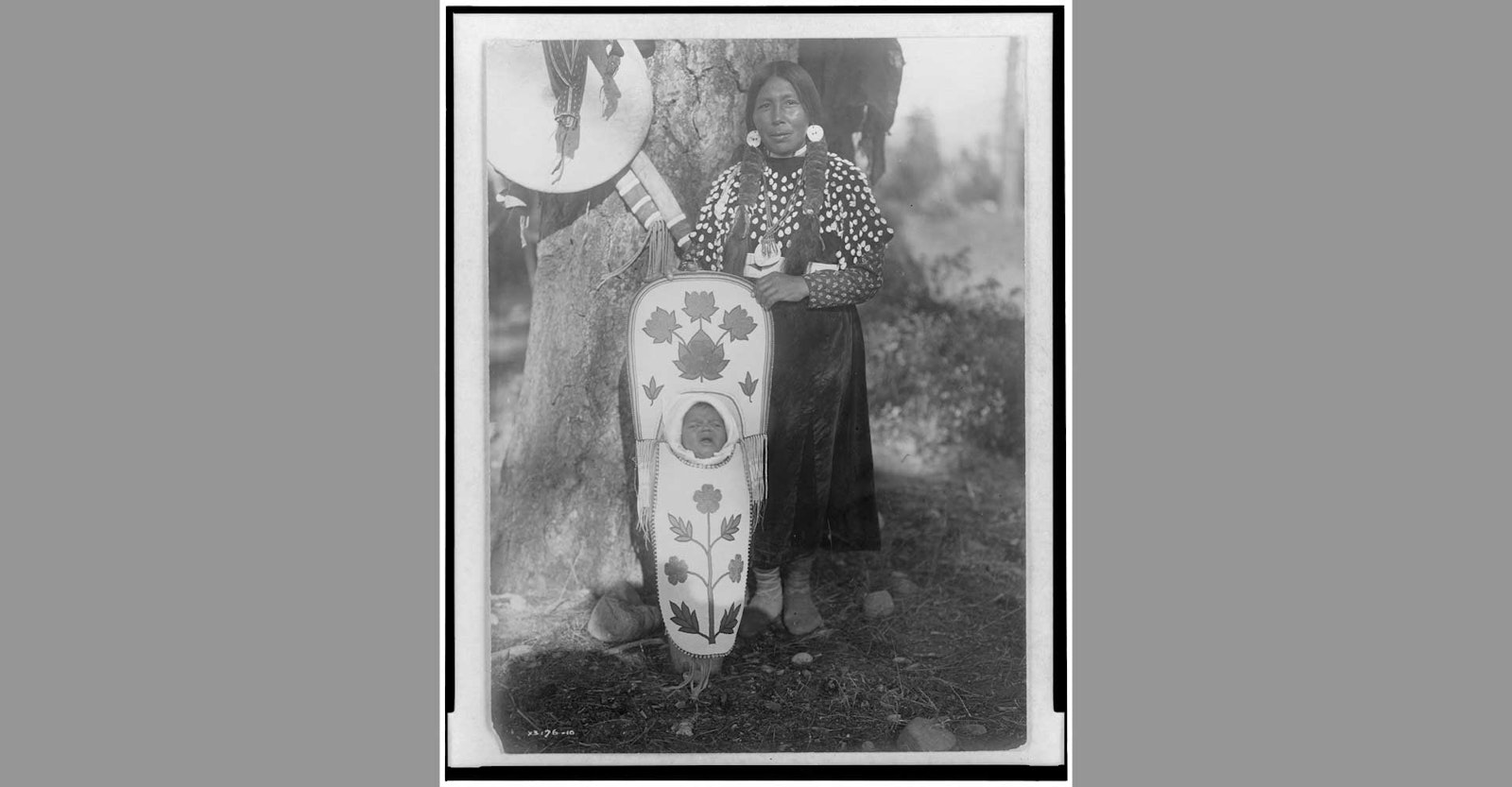Babies are considered precious in every culture—they are, after all, the way we carry our lineages into the future—but practices of caring for them vary considerably. One of the challenges that all people face is how to hold and transport such helpless beings. In modern society, we primarily turn to technological solutions: collapsible strollers and plastic carriers that can be used in and out of cars. For eons, however, simpler solutions prevailed. Most commonly, little ones were wrapped and tied to their mothers’ bodies. This arrangement provided physical and emotional security for the baby and kept the mother’s hands free to carry out everyday tasks.
In some cultures, the carriers were more than practical; the wrapping cloths were painstakingly and lovingly adorned. Native American cradleboards varied stylistically across North America and through time but were part of a long tradition where babies were encased in carriers covered with elaborate beadwork and embroidery. The carriers represented a considerable investment of time and creative energy and a wide array of designs and techniques. Despite the fact that babies would quickly outgrow their carriers, they were honored and protected in this way.

Apsáalooke (Crow) woman and baby, photographed by Edward S. Curtis, 1908. The beadwork on this cradleboard is done in the lane stitch. Note how the wrappings can be lashed more or less tightly, depending on the size of the baby. The wrappings can also be drawn around the head for extra protection. Photo courtesy of the Library of Congress Prints and Photographs Division
What Is a Cradleboard?
While there were many tribal variations, the most common carrier in native North America was the cradleboard. (This might also be called a cradle, baby board, baby basket, or, incorrectly, papoose). The construction consisted of a rigid frame made of wood or basketry fibers that served as the backing for a bag-like container that held the baby. She was well protected —kept tightly swaddled (laced-in) and calm, resting on soft padding. In winter, she might be further surrounded with fur. A top hoop or roll bar safeguarded her head and also offered shade. She enjoyed the bright colors of the embroidered wrappings and board coverings and the hanging adornments her mother might have added as amusements and spiritual protectors.
While a baby usually looked out at the world from the cradleboard on the mother’s back, the carrier’s rigidity also meant she could be propped up against a tree or even hung safely from a branch. Once she became more active, she might be secured with her arms free, but by the time she was weaned or highly mobile, she had probably outgrown this carrier.
Despite the short time it was used, a cradleboard was considered vital to the child’s development. Many felt its design mattered greatly; if it were made and ornamented well, it could help ensure the spiritual well-being of the baby. Materials were selected with care, and before the baby was even born, the father might select a certain type of wood and carve the frame. (Cradleboards constructed from basket materials were usually made by a female relative.) When the baby was first placed in the finished carrier, the family often held an honoring ceremony.

Right: Ka'igwu (Kiowa) Native North American, Great Plains cradleboard, Great Plains (44.620), circa 1900. Photo by RISD Museum, Providence Rhode Island Left: Apsáalooke (Crow) Native North American, cradleboard (17.017), circa early 1900s. (Detail.) Photo by RISD Museum, Providence, Rhode Island
Ornamentation
While the earliest images of cradleboards indicate that they were adorned with dyed porcupine quills, the tradition is strongly associated with beadwork. Once seed beads were readily available as trade goods in the nineteenth century, they quickly prompted creative exploration. Techniques depended on regional style; beads were usually strung on thread and couched down on a backing fabric, though there were recognizable variations in the way they were handled. In the eastern woodland spot-stitch style (learn more in “Bandolier Bags,” PieceWork Spring 2020), the thread was caught after every few beads and couched in curvilinear lines.
In the style that was more common in the Great Plains, the strung beads were allowed to “float” before being couched down in parallel rows. This latter technique has been widely known as the lazy stitch, although the less pejorative term lane stitch is now preferred. The resulting geometric patterns frequently totally covered the cloth surface.
Cradleboards & Cultural Shifts
When traditional lifeways were disrupted—when native people were forced onto reservations or taken to boarding schools where “Indianness” was systematically destroyed—the cradleboard tradition began to die out. The form remains a powerful symbol of traditional values, however, and there is something of a revival in indigenous communities. They are proudly displayed at powwows, tribal, or intertribal gatherings where traditional lifeways are celebrated.
Where do contemporary cradleboards come from? Some older examples are passed down through families. Others are newly made as welcoming gifts that reinforce the child’s family and cultural identity. To encourage this, there are now internet videos and classes explaining how to make cradleboards following particular tribal traditions. There are offerings, for example, on Navajo-, Kiowa-, Miami-, or Shoshone-style boards. In 2015, there was a Kickstarter campaign to fund Ojibwe-style cradleboard-making classes in Minnesota. Typically, these instructions focus on the supporting structures and ways to secure the babies; it is assumed that those who want to incorporate beadwork will have developed that skill already.
If there is no one in a family to make a cradleboard, it is also now possible to buy one, either in-person from an individual native entrepreneur or online from Etsy or a commercial producer such as the Canadian company Native Bebe. These modern examples don’t usually incorporate beadwork or represent the kind of intense labor seen in the older cradleboards.
At the opposite extreme is the kind of artwork created by Lakota artist Thomas Red Owl Haukaas. His fully beaded cradle designs build upon but also transcend tribal tradition. Each is named and holds a pointed message. In “Interconnected” (2007), for example, three turtles on each side represent the grandparents embodied within the child; seen from a distance, the turtles form DNA spirals. In “Economic Conundrum” (2010), scattered birds represent different reactions to economic downturn.
Haukaas explains that while beadwork was traditionally women’s work and the maternal aunt would have been the one to make a cradle, Lakota gender roles were turned upside down in the twentieth century, and cultural guardianship is what matters now. He has not only made many cradles for family members, but also mentors younger beadwork artists to ensure that the tradition continues to thrive.
Native American cradleboards have long served symbolic and utilitarian purposes. The many hours that would go into creating and embellishing the carriers points to the great esteem and love in which babies have been held. We can both marvel at the artistry in the needlework and appreciate why the carriers are so highly valued as family heirlooms and cultural touchstones.
Resources
- Bibby, Brian. Precious Cargo: California Indian Cradle Baskets and Childbirth Traditions. Novato, California: Marin Museum of the American Indian, 2004.
Beverly Gordon is a writer and artist committed to helping people appreciate both the material and inner, intuitive worlds. She is professor emerita in Design Studies at the University of Wisconsin-Madison, where she taught textile history and material culture for thirty years. She is the author of numerous books and articles, including Textiles: The Whole Story–Uses, Meanings, Significance (2011) and Shaker Textile Arts (1980). Learn more at www.beverlygordon.info.
This article was published in the Summer 2020 issue of PieceWork.

